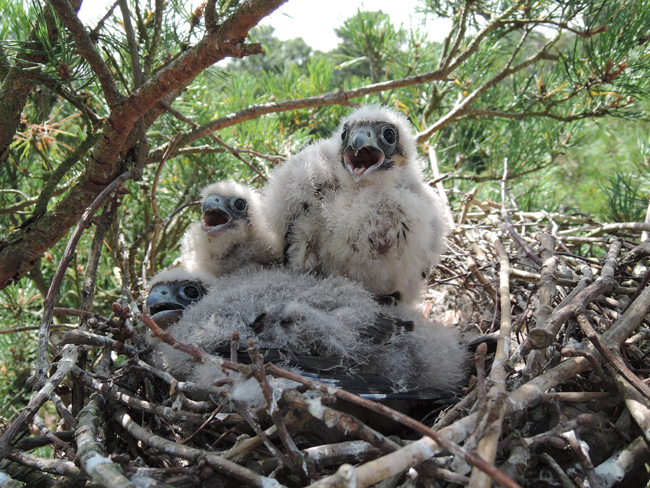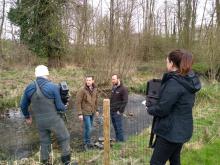
A former UK sand and gravel quarry is attracting rare birds of prey as it continues to be restored to a country park and nature reserve. Guy Woodford reports.
2018 has been an outstanding year for birds of prey at Panshanger Park with the presence of two rare species – hobby and osprey. A pair of hobbies has successfully bred in the 400-hectare historic park, raising three chicks, and in September an adult osprey visited the park for a prolonged stay of two weeks.
Healthy populations of predators at the top of food webs have long been recognised as indicators of the well-being of ecosystems. As well as demonstrating the quality of the restoration work being undertaken by
Owned by Tarmac and situated between Welwyn Garden City and Hertford in Hertfordshire, southern England, Panshanger Park was a sand and gravel quarry that is being progressively restored to a country park and nature reserve. Tarmac works in partnership with Herts and Middlesex Wildlife Trust to manage the park for both wildlife and people to enjoy, meticulously planning restoration work for nature conservation, agriculture and recreation.
In 2017, Tarmac, along with its partner, Herts and Middlesex Wildlife Trust, received top honours at the Mineral Product Association’s Restoration and Biodiversity Awards at the Royal Society in London. The partnership received the prestigious Cooper-Heyman Cup in recognition of its work to sensitively restore and manage the grade II* listed landscape at Panshanger Park.
Hobbies are migratory falcons that visit southern Britain to breed before returning to sub-Saharan Africa for the winter. They feed on dragonflies and damselflies, as well as smaller birds including martins and swallows, catching their prey in mid-air and, with insect prey, feeding on the wing. There are around 2,000 pairs of hobbies in the UK and the health of the expanding population has been linked to the increase in their dragonfly prey around restored gravel pits like those being created by Tarmac at Panshanger Park.
Tarmac’s Enrique Moran Montero, restoration manager at Panshanger Park, says: “We are delighted to see these rare falcons in the park. Their presence is a reflection of the high-quality habitats that have been created and allowed to establish and flourish.”
Following consultation with species protection experts, a series of special Hobby Watch events was hosted by Tarmac so that members of the public could view the hobbies through telescopes, learning more about them and the protection that they require from the people and wildlife officer. More than 100 people attended these events and everyone, including the younger watchers, was able to see the birds.
Murray Brown, Panshanger Park people and wildlife officer, said: “We were thrilled to have a family of hobbies at Panshanger. They are a joy to watch; capable of rapid bursts of speed and breathtaking turns as they hunt.”
Ospreys have been stopping at Panshanger Park for several years as they follow their long migration routes between northern Europe and tropical Africa. This year, an adult bird stayed for two weeks affording birdwatchers, photographers and visitors amazing views of this remarkable bird of prey from the bespoke viewing platform that has been provided by Tarmac.
Brown added: “The sight of a fishing osprey plunging feet first into a lake to catch large fish in its specially adapted talons, has to rank among the most awe-inspiring of wildlife experiences in Britain. We’re so pleased that this spectacle could be enjoyed by so many people at Panshanger Park.”
The visit from the osprey is just one example of how the quarry restoration work at Panshanger Park is creating new habitat that, with careful management, can work side by side with recreational use. Some of the lakes created at the site through the restoration process are stocked with brown and rainbow trout by a fly fishing club in agreement with Tarmac. Before mineral extraction, these areas were grassland. The anglers fully appreciate that their sport is enriched by fishing alongside breeding reed, sedge and Cetti’s warblers and little and great crested grebes. Kingfishers, grey wagtails and little egrets are also frequently seen.
Restored sand and gravel quarries are perfect sanctuaries for a whole host of flora and fauna and there can be little doubt that the habitat creation work of companies like Tarmac is greatly benefitting wildlife in the UK. Lakes and rivers in such areas may be surrounded by land that is not extensively used for commercial agriculture and so escape excessive inputs of artificial nutrients. At Panshanger Park, the sinuous Broadwater, designed by the 18th century English landscape gardener, Humphrey Repton, is complemented by other water bodies created after gravel extraction, providing ideal hunting grounds for hobbies and ospreys. The submerged aquatic plants, marginal species and reedbeds also provide habitats for water voles, amphibians and wintering wildfowl and the associated invertebrate life provides feeding opportunities for birds, bats and dragonflies. Panshanger Park is home to nearly half of the UK’s species of dragonflies and damselflies and is the second richest site in Hertfordshire for these stunning insects.
Landscapes like this provide critical havens for wildlife and act as stepping stones for species to move through a wider countryside dominated by intensively farmed or developed areas, thereby connecting them to other suitable habitats. While most of the park has open access and a series of managed permissive rights of way, it’s vital that some undisturbed refuges are left protected so that sensitive wildlife can flourish, ospreys can rest and refuel on their migrations, and birds like the fantastic hobbies can raise their young in safety.








